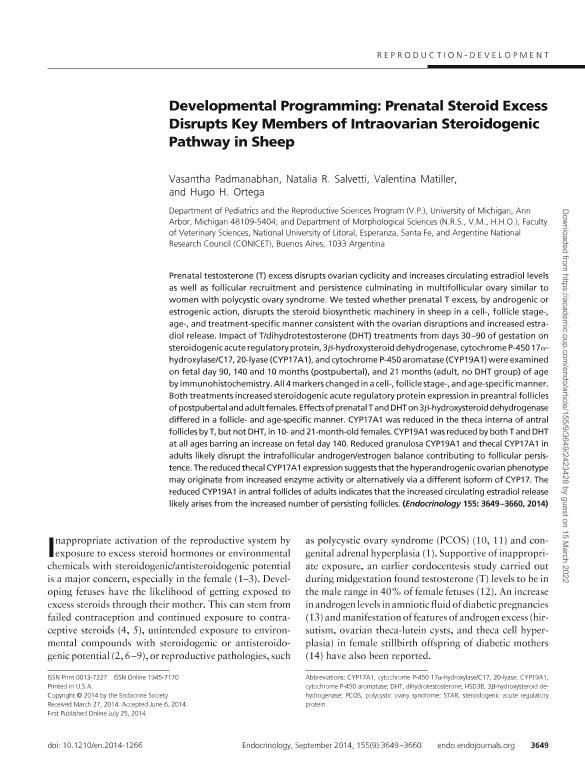Mostrar el registro sencillo del ítem
dc.contributor.author
Padmanabhan, Vasantha
dc.contributor.author
Salvetti, Natalia Raquel

dc.contributor.author
Matiller, Valentina

dc.contributor.author
Ortega, Hugo Hector

dc.date.available
2017-07-19T20:46:19Z
dc.date.issued
2014-08
dc.identifier.citation
Padmanabhan, Vasantha; Salvetti, Natalia Raquel; Matiller, Valentina; Ortega, Hugo Hector; Developmental programming: prenatal steroid excess disrupts key members of intra-ovarian steroidogenic pathway in sheep; Oxford University Press; Endocrinology; 155; 9; 8-2014; 3649-3660
dc.identifier.issn
0013-7227
dc.identifier.uri
http://hdl.handle.net/11336/20962
dc.description.abstract
Prenatal testosterone (T) excess disrupts ovarian cyclicity and increases circulating estradiol levels as well as follicular recruitment and persistence culminating in multifollicular ovary similar to women with polycystic ovary syndrome. We tested whether prenatal T excess, by androgenic or estrogenic action, disrupts the steroid biosynthetic machinery in sheep in a cell-, follicle stage-, age-, and treatment-specific manner consistent with the ovarian disruptions and increased estradiol release. Impact of T/dihydrotestosterone (DHT) treatments from days 30?90 of gestation on steroidogenic acute regulatory protein, 3-hydroxysteroid dehydrogenase, cytochrome P-450 17-hydroxylase/C17, 20-lyase (CYP17A1), and CYP19A1 were examined on fetal day 90, 140 and 10 months (postpubertal), and 21 months (adult, no DHT group) of age by immunohistochemistry. All<br />4 markers changed in a cell-, follicle stage-, and age-specific manner. Both treatments increased steroidogenic acute regulatory protein expression in preantral follicles of postpubertal and adult females. Effects of prenatal T and DHT on 3-hydroxysteroid dehydrogenase differed in a follicleand age-specific manner. CYP17A1 was reduced in the theca interna of antral follicles by T, but not DHT, in 10- and 21-month-old females. CYP19A1 was reduced by both T and DHT at all ages barring an increase on fetal day 140. Reduced granulosa CYP19A1 and thecal CYP17A1 in adults likely disrupt the intrafollicular androgen/estrogen balance contributing to follicular persistence. The<br />reduced thecal CYP17A1 expression suggests that the hyperandrogenic ovarian phenotype may originate from increased enzyme activity or alternatively via a different isoform of CYP17. The reduced CYP19A1 in antral follicles of adults indicates that the increased circulating estradiol release likely arises from the increased number of persisting follicles.
dc.format
application/pdf
dc.language.iso
eng
dc.publisher
Oxford University Press

dc.rights
info:eu-repo/semantics/openAccess
dc.rights.uri
https://creativecommons.org/licenses/by-nc-sa/2.5/ar/
dc.subject
Androgens
dc.subject
Immunohistochemistry
dc.subject
Estradiol
dc.subject
Adult
dc.subject
Aromatase
dc.subject
Fetus
dc.subject
Hair Follicle
dc.subject
Ovarian Follicle
dc.subject
Sheep
dc.subject
Steroid 17-Alpha-Monooxygenase
dc.subject
Steroids
dc.subject
Ovary
dc.subject
Prenatal Care
dc.subject.classification
Ciencias Veterinarias

dc.subject.classification
Ciencias Veterinarias

dc.subject.classification
CIENCIAS AGRÍCOLAS

dc.title
Developmental programming: prenatal steroid excess disrupts key members of intra-ovarian steroidogenic pathway in sheep
dc.type
info:eu-repo/semantics/article
dc.type
info:ar-repo/semantics/artículo
dc.type
info:eu-repo/semantics/publishedVersion
dc.date.updated
2017-07-07T20:07:13Z
dc.identifier.eissn
1945-7170
dc.journal.volume
155
dc.journal.number
9
dc.journal.pagination
3649-3660
dc.journal.pais
Reino Unido

dc.journal.ciudad
Oxford
dc.description.fil
Fil: Padmanabhan, Vasantha. Michigan State University; Estados Unidos
dc.description.fil
Fil: Salvetti, Natalia Raquel. Consejo Nacional de Investigaciones Científicas y Técnicas. Centro Científico Tecnológico Conicet - Santa Fe. Instituto de Ciencias Veterinarias del Litoral. Universidad Nacional del Litoral. Facultad de Cs.veterinarias. Instituto de Ciencias Veterinarias del Litoral; Argentina
dc.description.fil
Fil: Matiller, Valentina. Consejo Nacional de Investigaciones Científicas y Técnicas. Centro Científico Tecnológico Conicet - Santa Fe. Instituto de Ciencias Veterinarias del Litoral. Universidad Nacional del Litoral. Facultad de Cs.veterinarias. Instituto de Ciencias Veterinarias del Litoral; Argentina
dc.description.fil
Fil: Ortega, Hugo Hector. Consejo Nacional de Investigaciones Científicas y Técnicas. Centro Científico Tecnológico Conicet - Santa Fe. Instituto de Ciencias Veterinarias del Litoral. Universidad Nacional del Litoral. Facultad de Cs.veterinarias. Instituto de Ciencias Veterinarias del Litoral; Argentina
dc.journal.title
Endocrinology

dc.relation.alternativeid
info:eu-repo/semantics/altIdentifier/doi/http://dx.doi.org/10.1210/en.2014-1266
dc.relation.alternativeid
info:eu-repo/semantics/altIdentifier/url/https://academic.oup.com/endo/article-lookup/doi/10.1210/en.2014-1266
Archivos asociados
